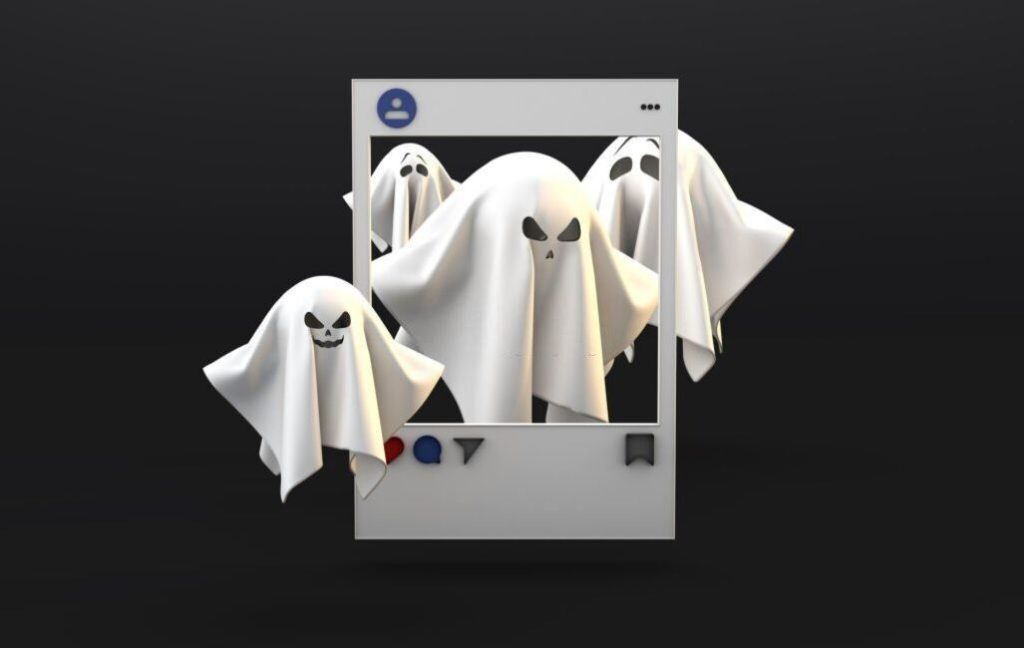Our daily lives are now closely intertwined with social media platforms. We use them to connect with friends and family, share our thoughts and experiences, and discover new ideas and content. And if you’ve ever used a social media platform, you’ve probably seen the little ghost mascot that has become a ubiquitous symbol of the genre.
The ghost mascot first appeared on one of the most popular social media platforms, Snapchat. Initially, the ghost was a simple, white silhouette with no facial features, meant to represent the ephemeral and fleeting nature of the platform’s content.
But over time, the ghost has evolved into a more complex and recognizable figure and has become a mascot for other platforms.
Today, the ghost mascot is instantly recognizable to millions of people worldwide and has become a pop culture icon in its own right. But how did this little specter become such a superstar? In this post, we’ll look at the evolution of social media’s ghost mascot, from its humble beginnings to its current status as a ubiquitous brand icon. Here, we will discuss which social media app has a ghost as its mascot?
The origins of the ghost mascot
The story of the ghost mascot begins with Snapchat, the social media platform that pioneered the concept of ephemeral messaging. When Snapchat was first launched in 2011, it was a simple app that allowed users to send photos and videos that would disappear after a few seconds.
To emphasize the temporary nature of this content, Snapchat’s co-founders Evan Spiegel and Bobby Murphy created a logo that would represent the idea of fleeting moments.
The original ghost mascot was designed by a graphic designer named Kalina Edwards. It was a simple, white silhouette of a ghost with no facial features, arms, or legs. The ghost was meant to convey the idea of something fleeting and impermanent and to remind users that the content they shared on Snapchat would only be visible for a short time.
Snapchat’s ghost mascot was an instant hit with users. Who began incorporating it into their own content and even creating their own versions of the logo. As Snapchat grew in popularity, the ghost became more and more recognizable, and its design began to evolve.
The evolution of the ghost mascot
Over the years, the ghost mascot has undergone many changes and adaptations over the years. As it has been used on different social media platforms and for various purposes. Here are some of the key developments in the ghost mascot’s evolution:
Facial features
One of the first changes to the ghost mascot’s design was the addition of facial features. Snapchat’s ghost originally had no eyes, mouth, or nose, but over time. These elements were added to give the ghost more personality and expressiveness.
Today, the ghost’s face is one of its most distinctive features and has become an essential part of its brand identity.
Redesigns
Like many brand logos, the ghost mascot has undergone several redesigns. Snapchat has experimented with different colors, shapes, and styles for the ghost to keep it fresh and appealing to users? Some of these redesigns have been more successful than others, but the ghost has remained recognizable and iconic overall.
Cross-platform adaptations
As other social media platforms began to adopt the ghost mascot. They put their own spin on it to fit their brand identity.
For example, Twitter’s ghost is blue instead of yellow and has a more cartoonish style. While Slack’s ghost is more minimalist and streamlined.
Each platform’s version of the ghost reflects its values and aesthetics while still retaining the core elements that make the ghost so recognizable.
New features
As social media platforms have expanded their offerings, the ghost mascot has evolved to reflect these changes. For example, on Snapchat, the ghost has been adapted to represent features like Snap Map and Bitmoji. While on other platforms, the ghost has been used to promote new features like group chats and video calls.
Through all these changes and adaptations, the ghost mascot has remained a powerful symbol of social media, representing the idea of connection, communication, and community. In the next section, we’ll take a closer look at the role of the ghost mascot as a brand icon.
The ghost mascot in popular culture
In addition to its role as a brand icon for social media platforms. The ghost mascot has become a pop culture phenomenon in its own right.
The ghost’s distinctive design and playful personality have made it a favorite among artists, designers, and creatives. Who have incorporated it into various media and contexts.
One of the most notable appearances of the ghost mascot in popular culture is in the Netflix series “Stranger Things.” In the show, the character Dustin wears a hoodie with the Snapchat ghost logo. Which has become an iconic element of his costume.
The use of the ghost mascot in “Stranger Things” is a testament to its wide-reaching appeal and shows. How it has become a symbol of youth culture and social media.
Outside of media and entertainment, the ghost mascot has also made its way into fashion, with numerous clothing brands featuring the ghost on t-shirts, hats, and other items.
The ghost’s simple yet iconic design has made it a natural fit for fashion, and its popularity among young people has made it a sought-after item among trendy consumers.
It you want to know some more about mascot, click on the Read More link.
Conclusion
The ghost mascot of social media platforms is more than just a cute, cartoonish symbol. It’s a powerful representation of how social media has transformed our world, bringing people together and creating new forms of communication and expression.
As we look to the future of social media and its role in our lives. The ghost mascot will continue to be a central figure. Reminding us of the connections and communities that make social media so meaningful.





